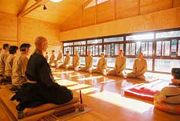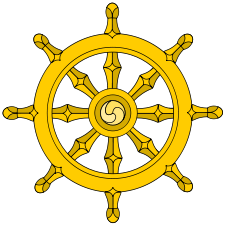Zazen
Zazen (坐禅; Chinese; zuò chán pinyin or tso-chan Wade-Giles) is at the heart of Zen Buddhist practice. The aim of zazen is just sitting, "opening the hand of thought".[1] This is done either through koans, Rinzai's primary method, or whole-hearted sitting (shikantaza), the Soto sect's method. (Rinzai and Soto are the main extant Zen schools in Japan; they both originated in China as the Linji and Caodong schools, respectively.) Once the mind is able to be unhindered by its many layers, one will then be able to realize one's true Buddha nature[2]. In Zen Buddhism, zazen (literally "seated meditation") is a meditative discipline practitioners perform to calm the body and the mind and experience insight into the nature of existence and thereby gain enlightenment (satori).
The posture of zazen is seated, with folded legs and hands, and an erect but settled spine. The legs are folded in one of the standard sitting styles (see below). The hands are folded together into a simple mudra over the belly. In many practices, one breathes from the hara (the center of gravity in the belly) and the eyelids are half-lowered, the eyes being neither fully open nor shut so that the practitioner is not distracted by outside objects but at the same time is kept awake.

Contents |
History and tradition
Long periods of zazen, usually performed in groups at a zendo (meditation hall), may alternate with periods of kinhin (walking meditation). The beginning of a zazen period is traditionally announced by ringing a bell three times (shijosho), and the end of a round by ringing the bell once (hozensho). Before and after sitting, Zen practitioners perform a gassho bow to their seat, to fellow practitioners and to the teacher/guru.
In Japan, seated zazen is traditionally performed on a mat called a zabuton while sitting on a cushion called a zafu. Master Dogen recommended only Kekkafuza and Hankafuza, still the common positions used to sit on the zafu are:
- Kekkafuza (full-lotus)
- Hankafuza (half-lotus)
- Burmese (a cross-legged posture in which the ankles are placed together in front of the sitter)
- Seiza (a kneeling posture using a bench or zafu)
In addition, it is not uncommon for modern practitioners to sit zazen in a chair, often with a wedge/cushion on top of the chair seat so that one is sitting on an incline, or by placing a wedge behind the lower back to help maintain the natural curve of the spine.
Methods
Very generally speaking, zazen practice is taught in one of three ways.
- Concentration
- Koan Introspection
- Shikantaza (just sitting)
Shikantaza is usually associated with the Soto school, and koan practice with the Rinzai school. In reality many Zen communities use both methods depending on the teacher and students.
Concentration
The initial stages of training in zazen will usually emphasize concentration. By focusing on the breath at the hara, often aided by counting. This counting meditation is called susokukan, and has several variations. Through this practice one builds up the power of concentration, or joriki. At some Zen centers, the practice of mentally repeating a mantra with the breath is used in place of counting breaths for beginners. In some communities, or sanghas, the practice is continued in this way until there is some initial experience of samadhi or "one-pointedness" of mind. At this point the practitioner moves to one of the other two methods of zazen.
Koan Introspection
Having developed the power of concentration, the practitioner can now focus his or her attention on a koan as an object of meditation. Since koans are, ostensibly, not solvable by intellectual reasoning, koan introspection is designed to shortcut the intellectual process leading to direct realization of a reality beyond thought.
Shikantaza (just sitting)
Shikantaza is objectless meditation, in which the practitioner does not use any specific object of meditation, but uses the power developed in concentration to remain completely aware of all phenomena that arise and pass in the present moment.
Comparison with other practices in Buddhism
Concentration practice in Zen is likened to the practice of samatha (concentration) in other schools of Buddhism. The eyes remain slightly open in zazen, as with the practice of samatha in the Tibetan Buddhist tradition and unlike in Theravada practice.
Concentration is foundational to most other forms of meditation in Buddhism. In actuality, all meditative practices, Buddhist and non-Buddhist, take concentration to execute, and therefore are concentration practices in and of themselves. Some teachers do not teach concentration as a separate practice, believing that it is developed through other practices.
Koan introspection and shikantaza are more likened to the vipashyana (insight) practice in Theravada, but are sometimes considered to be a condensation of vipashyana and samatha into a single practice. For this reason, shikantaza can also be referred to as samatha-vipashyana. Similarly, koan introspection, while leading to insight, requires an immense amount of concentration on the object of meditation (the koan).
See also
- Ango
- Keisaku
- Rinzai school
- Sesshin
- Shikantaza
- Soto
Further reading
- Austin, James H. Zen and the Brain: Toward an Understanding of Meditation and Consciousness. The MIT Press, 1999. ISBN 0262011646.
- Buksbazen, John Daishin. Zen Meditation in Plain English. Wisdom Publications, 2002. ISBN 0861713168. (Foreword by Peter Matthiessen.)
- Dogen. Beyond Thinking: A Guide to Zen Meditation. Shambhala, 2004. ISBN 1590300246.
- Harada, Sekkei. The Essence of Zen: Dharma Talks Given in Europe and America. Kodansha, 1998. ISBN 4770021992.
- Humphreys, Christmas. Concentration and Meditation: A Manual of Mind Development. Element Books, 1991. ISBN 1852300086.
- Kapleau, Philip (1989). The Three pillars of Zen: teaching, practice, and enlightenment. New York: Anchor Books. ISBN 0-385-26093-8.
- Loori, John Daido. Finding the Still Point: A Beginner's Guide to Zen Meditation. Shambhala, 2007. ISBN 1590304799.
- Loori, John Daido and Taigen Daniel Leighton. The art of just sitting: Essential writings of the Zen practice of shikantanza. Wisdom Publications, 2004. ISBN 086171394X
- Maezumi, Hakuyu Taizan, and Bernard Glassman. On Zen Practice: Body, Breath, Mind. Wisdom Publications, 2002. ISBN 086171315X.
- Warner, Brad. Hardcore Zen: Punk Rock, Monster Movies, & the Truth about Reality. Wisdom Publications, 2003. ISBN 086171380X.
In popular culture
In the Nintendo game Wii Fit, one of the balance games is called Lotus Focus; it's called Zazen in the European version. The player must sit still with their legs folded. The player wins when a candle melts all the way down. The candle lasts for 3 minutes (180 seconds). If the player makes a move, the announcer says "Katsu!" and ends the game. Meanwhile, creepy noises and a cough are heard in the background which may cause the player to lose concentration.
External links
- Instructions for Zen Meditation
- Zen Meditation Classes in English with Rev. Taka Kawakami at Shunko-in Temple (a sub-temple in the Myoshinji Temple complex in Kyoto
References
- ↑ Opening the Hand of Thought: Foundations of Zen Buddhist Practice, Kosho Uchiyama, Tom Wright, Jishō Cary Warner, Shohaku Okumura; Translated by Jishō Cary Warner, Shohaku Okumura; Contributor Tom Wright, Jishō Cary Warner, Shohaku Okumura, Wisdom Publications, 2004 ISBN 0861713575
- ↑ Kapleau 1989, p. 16
|
|||||
|
|||||||||||||||||||||||||||||||||||||||||||||||||||||||||||
